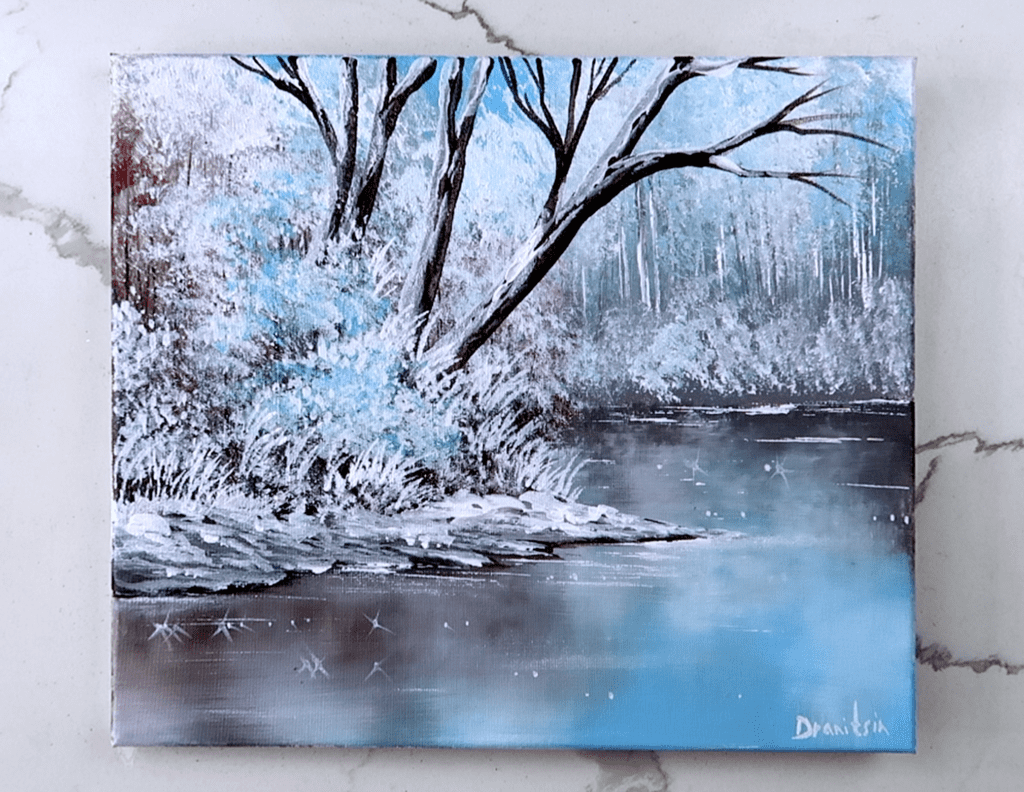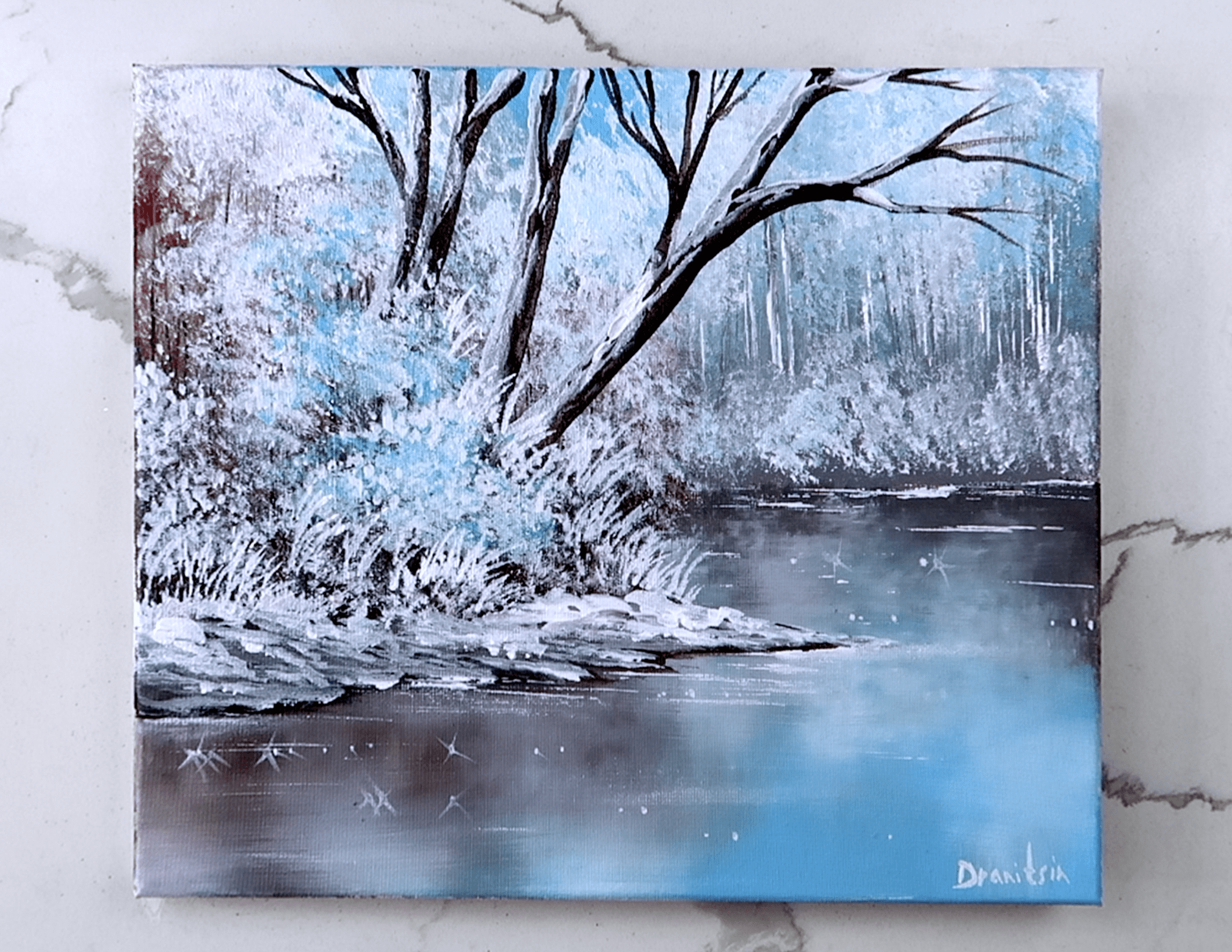A transformative dive into the art of painting serene water reflections with ease and precision!
🎯 Discover the Art of Water Reflections in Landscape Painting
Creating realistic water reflections can elevate your landscape painting to masterpiece status. With the right blend of acrylic painting techniques and thoughtful detailing, you can bring your canvas to life and capture the tranquility of still waters like never before. We’re here to guide you with expert-level painting tips and a breakdown of must-have art supplies to craft your next show-stopping artwork.
Let’s dive into the sparkling world of glittering lakes and realistic reflections while learning techniques that make your acrylic masterpiece come alive!
Tip: Want to perfect your reflections? Browse our Step-by-Step Painting Instructions for tailored tutorials on transforming your vision into a reality.
🌟 How to Master Capturing Stunning Water Reflections
1. Begin with a Strong Foundation
Start your acrylic painting with a well-planned composition. Sketch the landscape and identify where the water meets the land. This meeting point is key for perfect reflections—symmetry builds realism.
- Use high-quality acrylic paints to block in your base tones.
- Work from dark to light. Remember, water reflections are often slightly darker or distorted compared to their real object.
Pro Tip: For a smooth blending effect, grab a good set of paint brushes with soft bristles.
2. Mirror the Landscape in the Water
Reflections should mimic the surrounding environment. For instance:
- Trees should mirror their shapes downward, but blur or distort slightly.
- Clouds and skies need softer, blended edges. A round brush is essential for achieving these transparent layers.
3. Create Gentle Ripples
Add depth and energy to the water by painting ripples or subtle waves. Here’s how:
- Use thinner, horizontal brush strokes for calm waters.
- Apply acrylic glaze medium to layer translucent strokes for shimmering effects.
To bring out dynamic motion on water, see advanced painting techniques in action through YouTube tutorials.
4. Add Eye-Catching Highlights
Reflections on water often sparkle with highlights from the sun, moon, or surroundings. Use white or bright, vivid acrylic paint from our Shop Art Supply.
Paint these highlights with a fine-tip brush to add focus points in your design.
🔥 Essential Supplies for Painting Realistic Water in Acrylic
Upgrading your art game starts with having the right tools. Here’s a checklist for water-centric acrylic landscape painting supplies:
- Round Brushes & Flat Brushes – Great for creating smooth reflections and sharp ripples.
- Acrylic Paint – Vibrant colors and easy blending properties for depth and tone.
- Palette Knife – Perfect for adding reflective textures.
- Acrylic Glaze Medium – For added transparency in the reflections.
- Canvas Boards – Ensure your water effects pop out on solid surfaces.
Find premium art gear in our Shop Art Supply section!
🎨 Achieving the Perfect Atmosphere in Your Artwork
1. Play with Sunlight and Color Gradients
Water reflects light in unique ways. Use orange, pink, or gold tones for a sunrise/sunset atmosphere. Cooler shades like blue, green, and violet create serene, moonlit vibes.
Experiment with high-quality acrylic paints to achieve the full spectrum of tones.
2. Add Depth with Layers
For highly realistic reflections, work in layers. Start with base colors and gradually build upon them with finer brush strokes. You’ll need step-by-step guidance? Start leveraging Step-by-Step Painting Instructions.
3. Make Moments Pop
Don’t just settle for smooth water—add elements like:
- Floating leaves
- Reflections of birds or passing boats
- Rippling effects from stones or raindrops
These tiny details can transform your landscape painting into a timeless masterpiece.
🖼️ Showcase Your Artwork in Style
After mastering the art of painting water reflections, it’s time to showcase your creation! Upload your finished work to a Virtual Room Gallery to see how it shines in realistic settings or explore our Art Gallery for inspiration.
Need daily inspiration? Bookmark our Daily Blog for fresh ideas, tutorials, and painting challenges to improve your skills!
💡 Final Thoughts on Perfecting Water Reflections
Capturing a scene with tranquil waters and sharp reflections is the hallmark of exceptional landscape art. From glowing sunsets mirrored on a calm lake to distorted tree shapes shimmering in ripples, the beauty lies in the details. Keep practicing, experimenting, and investing in high-grade art supplies to achieve your ideal style.
Do you need custom-designed merch?
If you’re looking for professional logo designs or T-shirt graphics, visit our sister brand: MyEventArtist.com for premium services.
🌟
Keywords:
acrylic painting, water reflections, rippling lake effects, landscape painting techniques, serene water scenes, painting with acrylics, brush blending techniques, painting with layers
🌟
Hashtags:
#AcrylicPainting, #WaterReflectionsArt, #LakePaintingTips, #LandscapeArtistry, #ArtSupplies, #PaintingTechniquesWithAcrylics, #ScenicArtworks, #MasterYourBrushStroke

Capturing Tranquil Waters: Tips for Painting Realistic Water Reflections
Immerse yourself in the serene beauty of painting water reflections with confidence and precision. This guide is tailored to beginner artists seeking to enhance their acrylic landscape paintings by mastering the art of realistic water reflections. Dive into the world of captivating waterscapes and unlock the secrets to painting tranquil reflections. For further painting tips, step-by-step instructions, free art video tutorials, unconventional paint brushes, and more, be sure to visit UrArtStudio at https://urartstudio.com.
- Observe the Ripple Effect: Take time to observe various bodies of water and their characteristics. Notice how the surface ripples, whether it’s a calm lake or a flowing river. Pay attention to the size, frequency, and direction of the ripples. By studying these details, you’ll be able to recreate realistic reflections that truly capture the essence of water.
- Understand Mirror-like Reflections: Mirror-like reflections occur when the water’s surface is perfectly calm, reflecting the landscape above it. To master this effect, paint the landscape in the same way it appears above the water. Apply smooth brushstrokes to create a seamless transition between the landscape and the reflection.
- Create the Illusion of Depth: Depicting the depth of water is crucial for achieving realistic reflections. Gradually intensify the colors and values in the reflection as they appear deeper in the water. Use lighter and more vibrant strokes for objects closer to the water’s surface, while darker and more subdued tones should be applied to objects partially submerged or distant from the shore.
- Embrace Transparency: Water has a transparent nature that affects the appearance of objects beneath its surface. To achieve this effect, use a lighter and softer touch when painting the objects reflected in the water. Employ translucent layers of color to portray the water’s transparency accurately while maintaining the integrity of the reflection.
- Mind the Perspective: Remember that reflections are subject to perspective. As objects recede into the distance, their reflection becomes smaller in size and less detailed. Pay attention to the relationships between objects and their reflections in terms of size, shape, and position. This attention to perspective will lend credibility to your painting and create a sense of depth.
- Experiment with Texture: Texture plays a crucial role in capturing the authenticity of water reflections. Utilize different brush strokes and techniques to recreate the rippling effect. Experiment with dry brushing for a rough water texture or employ soft, feathery strokes to depict a calm and glassy surface. By incorporating texture, you can add life and movement to your painting.
- Play with Lighting and Color: The interplay of light and color is essential in creating realistic water reflections. Observe how light interacts with the water’s surface and alters the appearance of reflections. Adjust the colors, tones, and values of the reflection based on the lighting conditions to achieve a harmonious and visually striking result.
Unleash your creativity and immerse yourself in the captivating art of painting water reflections. To further develop your skills, find comprehensive guidance, step-by-step instructions, and unconventional paint brushes to enhance your artwork, visit UrArtStudio at https://urartstudio.com. Let your paintings come to life with serene and realistic water reflections, and watch your artistic journey flourish.



Leave a Reply
You must be logged in to post a comment.